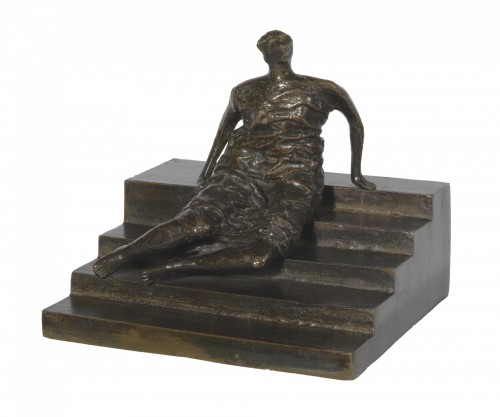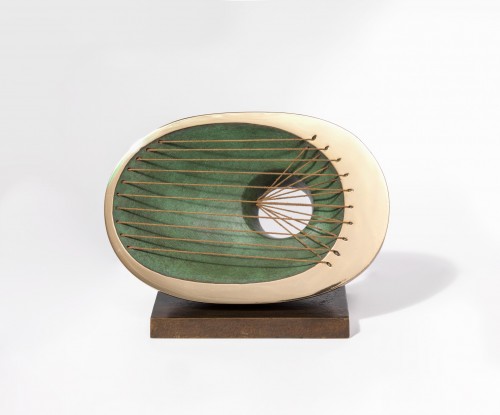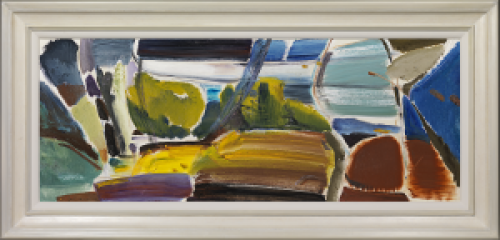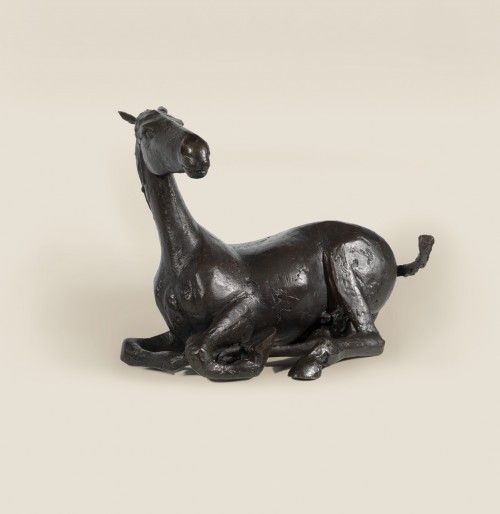HENRY MOORE OM CH
Castleford 1898 - 1986 Much Hadham
Ref: BR 27
Maquette for Figure on steps
Bronze with a brown patina: 6 ½ x 7 ¼ x 6 ½ in /
16.5 x 18.4 x 16.5 cm
Conceived in plaster and cast in 1956 at Fiorini in an unnumbered edition of 10 plus one artist’s copy
LH 426
Provenance:
Private collection, California
James Goodman Gallery, New York
Sidney E Frank, USA
Exhibited:
Florence, Forte di Belvedere, Mostra di Henry Moore, 20th May–30th September 1972, no.97 (another cast)
New York, Metropolitan Museum of Art, A Monumental Vision: Henry Moore: Sixty Years of His Art, 1983 (another cast)
London, Tate Modern, Cubism and its Legacy: The Gift of Gustav and Elly Kahnweiler, 24th May–7th November 2004; Tate Liverpool, 21st December 2004–2nd May 2005, no.44 (another cast)
Literature:
Ionel Jianou, Henry Moore, Arted, Paris 1968, no.398, p.81
William S. Lieberman, Henry Moore: Sixty Years of His Art, exh. cat., Metropolitan Museum of Art and Thames & Hudson, New York 1983, p.124 (another cast reproduced p.83)
Alan Bowness (ed.), Henry Moore Complete Sculpture 1955–64, vol. 3, Lund Humphries, London 2005, no.426, p.35, another cast illus. p.34
Giorgia Bottinelli, ‘Maquettes’ in Jennifer Mundy (ed.), Cubism and its Legacy: The Gift of Gustav and Elly Kahnweiler, exh. cat., Tate Modern, London 2004, pp.84–5, another cast illus. p.85
During the mid-1950s a series of public commissions (including a monumental sculpture for the UNESCO headquarters in Paris) inspired Moore to explore the integration of figurative sculpture in an architectural setting. As a result he created a group of drawings and maquettes which feature draped figures seated on or against geometric architectural elements such as benches and steps. While the setting of the seated figure was a departure for Moore, the
draped figure recalled an interest apparent in his earlier shelter drawings. Moore’s interest was revitalised by his visit to Greece in 1951, inspiring a return to the study of drapery and its importance in the revelation of form: ‘Drapery can emphasise the tension in a figure, for where the form pushes outwards, such as on the shoulders, the thighs, the breasts, etc., it can be pulled tight across the form (almost like a bandage), and by contrast with the crumpled slackness of the drapery which lies between the salient points, the pressure from inside is intensified.’[1] Moore’s first draped figure conceived in bronze was the Reclining figure commissioned for the Time-Life building in 1952–53, during which he developed a technique that undoubtedly informed the modelling of diaphanous material represented here: ‘gradually I evolved a treatment that exploited the fluidity of plaster. The treatment of drapery in my stone carvings was a matter of large, simple creases and folds but the modelling technique enabled me to build up large forms with a host of small crinklings and ruckings of the fabric.’[2]
Other casts of Maquette for Figure on steps are in the collections of the Tate Gallery, London and the Hirshhorn Museum and Sculpture Garden, Washington DC.
[1] The artist cited in P James, Henry Moore on Sculpture, MacDonald, London 1966, p.231.
[2] Ibid., p.230.
























